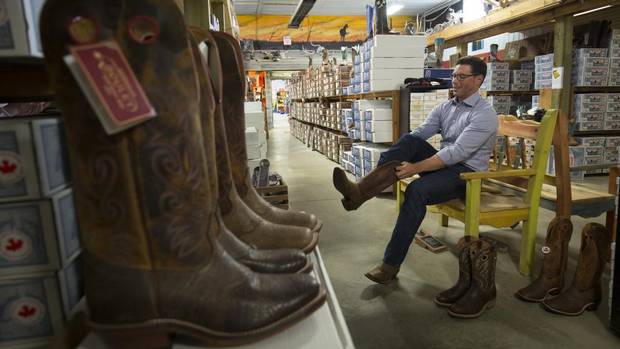Doug Schweitzer is shopping for cowboy boots. Brown. Traditional. A lower heel. Pointy yet square toes.
"A little bit of style would be good," he says. "But not too much."
Mr. Schweitzer wants to win the provincial election in 2019, which first means securing the leadership of the proposed United Conservative Party in October, which means avoiding fashion mishaps over the next 10 days. The Calgary Stampede is under way and politicians are playing dress-up, trying to out-grassroots each other. They want their cowboy boots and belt buckles to show they are just like the "Real Albertans" they court for votes.
Related: Corporate Stampede celebrations muted despite points of optimism
Related: Notley, Nenshi optimistic on economy as Calgary Stampede kicks off
Albertans are unfamiliar with Mr. Schweitzer and this is his first Stampede as a politician. It is a chance to raise his profile and prove the Calgary lawyer is not just some city boy. Indeed, Stampede costumes come with political consequences. Premier Rachel Notley was busted wearing her hat backward in 2015, an unforgivable Stampede sin. Photos of former prime minister Stephen Harper in a leather vest, poorly shaped hat and bolo tie can never be unseen. He wore the outfit 12 Stampedes ago.
And so Mr. Schweitzer asked The Globe and Mail to accompany him while acquiring boots so he doesn't step in it during Stampede. He suggests Alberta Boot Co. It is a Calgary operation with Alberta right in the name, making it a politically savvy choice. It is legit, but not the pinnacle of cowboy culture. If you're competing for cred, you have to go to Irvine's. Mr. Schweitzer had never heard of it, but if it means upping his Stampede game, he's in.
Irvine Tack & Western Wear – Canada's largest western store, covering 65,000 square feet of retail space – is just off a gravel road in another universe 58 kilometres north of the Calgary Tower. Here, near Crossfield, people know tack belongs in barns.
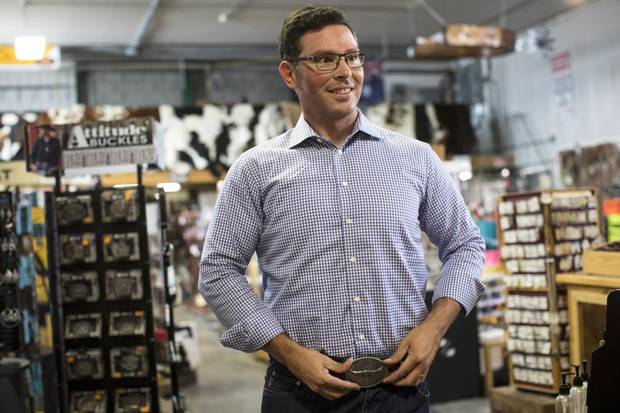
Doug Schweitzer, leadership candidate for Alberta’s United Conservative party, at Irvine Tack & Western Wear near Crossfield, Alta.
Todd Korol/For The Globe and Mail
Mr. Schweitzer spots a pair of Boulet boots. The heels are the right height, the toes are pointy until they square off at the tips, and pink dominates the traditional embroidery on the parts that jeans cover. There's just one thing that looks off to corporate cowboys: They extend well up the calf, to better protect people's legs when they're riding horses. Mr. Schweitzer asks a salesperson whether they are popular.
"Mostly cowboys wear that," she says, politely brushing off his interest. She means real cowboys – the kind of men who starch snap-button shirts before riding bulls, not iron the checked buttonhole numbers executives wear at company picnics. She means these boots are out of Mr. Schweitzer's league.
He asks whether they come in a size 12. "Let's try the real deal," he says. He needs a half-size smaller. He pulls up his Brax jeans and yanks on the pink finger loops to get the boots on.
"I'm going to get these ones," Mr. Schweitzer says. The Boulets are, indeed, a safe choice. "Done and done."
Wildrose Party Leader Brian Jean, not wanting to lose Alberta's high-profile competition to appear relatable, accepted The Globe's offer to supervise his boot shopping this year. Jason Kenney, Alberta's Progressive Conservative Party Leader, declined to subject himself to shopping with The Globe unless the newspaper paid the bill. Given the terms, The Globe is not responsible for his questionable footwear. The three men are challenging each other for leadership of the proposed United Conservative Party and for that they must demonstrate a high degree of grassrooty-ness.
Hollywood popularized cowboy boots in the 1920s, with actors wearing boots for the same reason politicians wear them during Stampede: playing pretend. Movie stars made cowboy boots fashionable but the footwear's history stretches back roughly 1,000 years, according to Elizabeth Semmelhack, the curator at the Bata Shoe Museum in Toronto. These days, folks tend to buy cowboy boots to fit in, not because they are practical for steer wrestling.
"There's no benefit to wearing a 'cowboy boot' that doesn't look like one," Ms. Semmelhack says. "People are exploiting its value as a cowboy boot."
And that's why Mr. Schweitzer spends $414.59 on boots, a belt and a buckle he'll only wear a couple of days a year.
Wildrose's Mr. Jean shows up at Alberta Boot Co. in boots from Alberta Boot Co.
Four Wildrosers and his official photographer accompany the experienced politician. The folks at the western shop are expecting Mr. Jean; one gives him a custom-made Wildrose belt buckle.
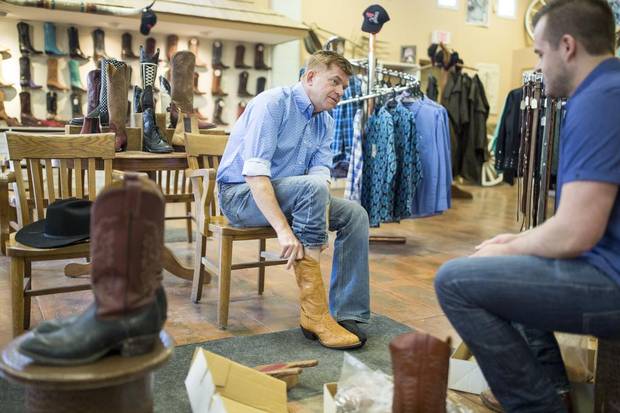
Brian Jean tries on some cowboy boots.
Chris Bolin
Alberta Boot's staff know what they want him in: ostrich. Ostrich on the bottom with a kangaroo shaft. The boots are a shade or two lighter than Mr. Jean's fading ginger hair. Ostrich leather sports tiny spikes; kangaroo is silky. These are going-out boots – the kind you'd wear to a wedding dance where the hosts serve midnight lunch.
Mr. Jean knows ostrich is expensive and asks the staff whether he'll have to take out a small business loan to cover the bill.
"I've never had a pair of ostrich boots," Mr. Jean says. "If you're going to get something, get it to last. Good value."
He asks his entourage for opinions. Just the right amount of flair, one says. The heels are high, the toes pointy, embroidery traditional, but the honey colour and spikes bring swagger. Mr. Jean, wearing a beaver felt cowboy hat he picked up at Irvine's the other day, declares the boots perfect.
"I'll take them," he says.
And a blue shirt. And a white cowboy hat. And a belt, which Alberta Boot will soon make to match his boots. Total: $764.30, after the friends-and-family discount on the boots but before the forthcoming belt. The price is a political trade-off. On one hand, real cowboys know the ostrich-kangaroo combo is legit. On the other, real cowboys know the ostrich-kangaroo combo is pricey.
Meanwhile, Jason Kenney plans to wear a scuffed up pair of tan ropers.
"Right now I'm an unemployed schmuck who can't afford new boots," he said on Twitter in June. Ropers have laces, shorter but wider heels, round toes, and lack decorative flair. They extend beyond the ankle, but not much further. They are perfectly acceptable Stampede gear.
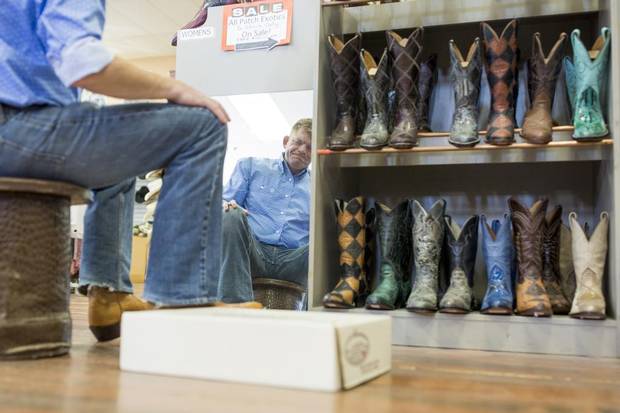
Brian Jean tries on some cowboy boots.
Chris Bolin
"They don't kill your feet after the 10th event of the day," the former federal cabinet minister said on Twitter. This justification echoes a statement he tweeted in 2016, when he wore a black pair. Stampede does, indeed, involve a lot of standing around. But if Real Albertans consider heeled cowboy boots comfy enough to work in 365 days a year, politicians can survive handshake lines for a few hours. And ropers are risky: People who do not know the difference between a header and a heeler may not recognize them as credible Stampede footwear. Mr. Kenney's fiscal conservatism could cost political capital.
While politicians are required to wear boots during Stampede, real cowboys and cowgirls are not. Outriders – the fellas on horseback chasing chuckwagons during races – often wear sneakers, for example. But those athletes literally sprint before jumping on their horses, and make money doing it. It is, for about 75 seconds a day, their job.
So if you feed and ride horses free from political motivation or without paying for the privilege to do so at Stampede, you can wear whatever you want. But if you're working the crowds rather than crowding the corrals, cowboy boots with proper heels and embroidery are the best choice. Be careful, though – new kicks can hurt your feet.
"I may or may not have a really large blister after day one in my new boots," Mr. Schweitzer, the rookie, said on Twitter on Thursday. "Any tips out there for breaking in boots during Stampede?"
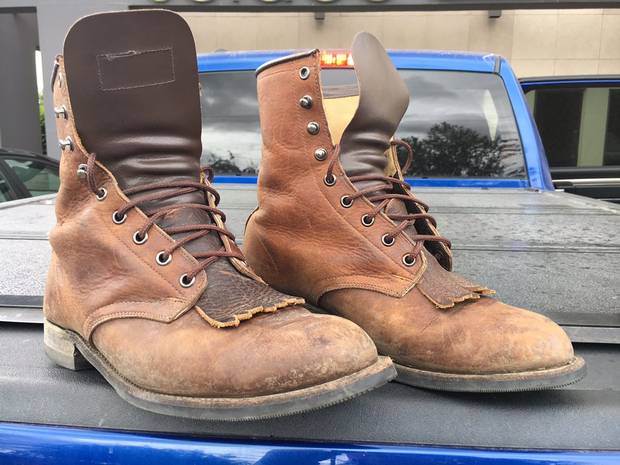
Chris Bolin
In cowboy boots, everybody's faking it
Cowboy boots are for poseurs.
Even farmers, ranchers and working cowboys – folks who brand cattle, fence, pull calves and drink Bud Light Lime only in case of emergency – are faking it when they pull on a pair. Ditto for the chief executives, bull riders, barn hands you see at the Calgary Stampede. Today's interpretation of cowboy boots looks little like its ancestors, which can be traced back to at least the 10th century.
"The more gussied examples [of cowboy boots] that you see at Stampede come more from 20th-century romaticization about a time period long gone," Elizabeth Semmelhack, a shoe historian, said. "It is more fantasy than fact."
Boot heels emerged in Persia by the 10th century, she said. Then, men wore heeled footwear to better secure themselves in stirrups while riding horses. This allowed them to better handle large weaponry.
Modern cowboy boots date back to pop-up shops at American railheads around 1870. This era birthed two of the most famous cowboy boot companies, but yesteryear's gear lacked the characteristics common in today's cattle chutes. Pointy toes, for instance, would not become prominent for another 70 years, Ms. Semmelhack said. She researched cowboy boots for her book – Standing Tall: The Curious History of Men in Heels – and is the Bata Shoe Museum's curator.
In the olden days, working cowboys on horseback would drive cattle for hundreds of miles to cities where the animals were loaded on trains destined for slaughterhouses. At the time, cowboys wore Civil War-era military boots. But after collecting paycheques at the railhead, they had money to burn on bespoke footwear. Perhaps they were feeling flush and full of swagger, perhaps they legitimately needed new kicks. Regardless, boot makers congregated at railheads to meet demand around 1870.
By then, roughly 120 entrepreneurs were producing boots in Kansas alone, according to Barbara Brackman's research published in the scholarly journal Kansas History: A Journal of the Central Plains. Merchants sold pull-on and lace-up boots. They were plain but practical for working cowboys. Heels were small and functional.
Hyer Boot Co. and Justin Boots – big-time names in today's cowboy footwear – have roots at the railheads, according to Ms. Brackman. Hyer was founded 1875 in Olathe, Kan.; Justin came along in 1879 in Spanish Fort, Texas. (Western Leather Goods purchased Hyer's successor company, dubbed Olathe Boot Co., in 2001. Western also owns Rios of Mercedes, which established in 1853, and Anderson Bean Boot Co., a newbie launched in 1989).
And then came Hollywood, Wild West shows, and rodeos at the turn of the century. Entertainers, not actual cowboys, latched on to pointy toes, higher heels and decorative work, Ms. Semmelhack said. Meanwhile, dude ranches became vacation hot spots because wealthy Americans steered clear of Europe during the First World War. Folks wore exaggerated western wear so not to be confused with actual ranch hands, according to the historian.
Movie stars in the 1920s took the boots mainstream, particularly Hollywood darling Tom Mix. As silent black-and-white westerns boomed, movie extras dressed in full costume used to congregate at soda counters in drugstores during film breaks, Ms. Semmelhack said. "Drugstore cowboys" emerged as a term for imposters but a model for today's take on cowboy attire.
"It seems to really be Hollywood that helped to push forward this iconic look of the cowboy boot as we recognize it," she said.
Traits that define today's cowboy boots – pointy toes, a splash of flash, high heels – were codified in the early 1940s, she said. This style has evolved little over the subsequent seven decades because the look became popular for being popular.
"Once it becomes iconic and recognizable as a 'cowboy boot,' then people basically are wearing it for its iconic value," Ms. Semmelhack said.
MORE FROM THE GLOBE AND MAIL:
